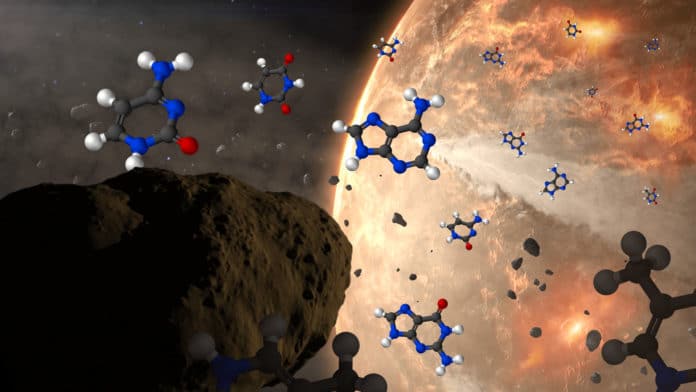DNA and RNA contain the information and instructions to build and operate every living being on Earth.
These RNA and DNA contain informational components called nucleobases.
Nucleobases belong to classes of widely varied organic molecules called purines and pyrimidines.
There are a total of 5 nucleobases in DNA and RNA. These are cytosine, guanine, adenine (found in both DNA and RNA), thymine (found only in DNA), and uracil (found only in RNA).
To date, scientists scouring extraterrestrial samples have only found three of the five.
Using new analyses, a team of scientists led by Associate Professor Yasuhiro Oba of Hokkaido University, Hokkaido, Japan, have just found the last two of the five informational units of DNA and RNA that had yet to be discovered in samples from meteorites.
A diverse suite of exogenous meteoritic organics, including nucleobases, may have been delivered to the early Earth during the late heavy bombardment period. Therefore, the influx of such organics is considered to have played an essential role in the chemical evolution of the Earth’s early stage.
“Recent sample return missions from the asteroids Ryugu and Bennu led by the Japan Aerospace Exploration Agency (JAXA) and the National Aeronautics and Space Administration (NASA), respectively, will provide us with important insights into the evolution of extraterrestrial organic molecules, and potential clues regarding the origins of life on Earth through chemical analyses of pristine extraterrestrial materials that have not been significantly compromised by terrestrial contamination.” Study mentions
“I wonder why purines and pyrimidines are exceptional in that they do not show structural diversity in carbonaceous meteorites unlike other classes of organic compounds such as amino acids and hydrocarbons,” said Oba, lead author of a paper about the research published April 26 in Nature Communications. “Since purines and pyrimidines can be synthesized in extraterrestrial environments, as has been demonstrated by our own study, one would expect to find a wide diversity of these organic molecules in meteorites.”
“We now have evidence that the complete set of nucleobases used in life today could have been available on Earth when life emerged,” said Danny Glavin, a co-author of the paper at NASA’s Goddard Space Flight Center in Greenbelt, Maryland.
This newly discovered pair of nucleobases, cytosine and thymine have been elusive in previous analyses.
Major reason behind it must be their more delicate structure, which may have degraded when scientists previously extracted samples. In the earlier experiments, scientists created something of a “meteorite tea,” placing grains of meteorite in a hot bath to let the molecules on the sample extract into the solution and then analyzed the molecular makeup of the extraterrestrial broth.
“We study these water extracts since they contain the good stuff, ancient organic molecules that could have been key building blocks for the origin of life on Earth,” said Glavin.
The delicacy of these nucleobases created skepticism in the team about observing their presence in samples.
But then, what contributed to the discovery?
The team used cool water to extract the compounds instead of hot formic acid in this study. Hot formic acid is very reactive and could destroy these fragile molecules in previous samples.
Second, more sensitive analytics were employed that could pick up on smaller amounts of these molecules.
“This group has managed a technique that is more like cold brew than hot tea and is able to pull out more delicate compounds,” said Jason Dworkin, a co-author of the paper at NASA Goddard. “I was amazed that they had seen cytosine, which is very fragile.”
The finding doesn’t provide a smoking gun as to whether life on Earth got an assist from space or came about exclusively in the prebiotic soup in the planet’s infancy. But completing the set of nucleobases that make up life today, in addition to other molecules found in the sample, gives scientists who are trying to understand the beginning of life more compounds to experiment with in the lab.
“This is adding more and more pieces; meteorites have been found to have sugars and bases now,” Dworkin said. “It’s exciting to see progress in the making of the fundamental molecules of biology from space.”
This analysis added to the kit for those modeling the inception of life on Earth and it also provides a proof of concept for a more effective technique to extract information from asteroids in the future, especially from the samples of Bennu making their way to Earth in the next year via NASA’s OSIRIS-REx mission.
Journal Reference
- Yasuhiro Oba, Yoshinori Takano, Yoshihiro Furukawa, Toshiki Koga, Daniel P. Glavin, Jason P. Dworkin & Hiroshi Naraoka. Identifying the wide diversity of extraterrestrial purine and pyrimidine nucleobases in carbonaceous meteorites. Nature Communications volume 13, Article number: 2008 (2022). DOI: 10.1038/s41467-022-29612-x
